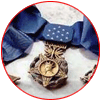Pueblo Medal of Honor Memorial at Pueblo Convention Center
Heroes Plaza
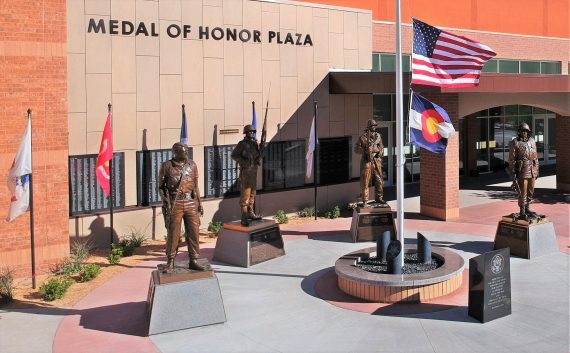 Bronze artist David Dirrim and granite artist William Yates, both Colorado natives, were selected in 1998 to create the Pueblo Medal of Honor Memorial outside the Convention Center on Heroes Plaza.
Bronze artist David Dirrim and granite artist William Yates, both Colorado natives, were selected in 1998 to create the Pueblo Medal of Honor Memorial outside the Convention Center on Heroes Plaza.
In addition to the statues of Pueblo’s four heroes the names of the over 3,500 recipients were incorporated on granite slabs mounted on the walls of the Convention Center just behind the sculptures. Listed by war, the names are in alphabetical order.
Other features are a 35 foot flag pole in the center of a garden which includes three granite columns that have Medals of Honor etched in granite. On the granite bench surrounding the garden are the words of President Dwight Eisenhower who, upon placing the Medal of Honor around Raymond “Jerry” Murphy’s neck in 1953 said: “What is it in the water out there in Pueblo, all you guys turn out to be heroes?”
The granite block on which each sculpture sits has a citation as well as a map of where their action took place, plus other awards they wished listed. It is important to note that each of the recipients depicted spent time working with Dirrim at his foundry to assure that the uniforms and equipment included in the sculptures was accurate.
The Pueblo Medal of Honor Memorial is located at the Pueblo Convention Center 320 Central Main Street Pueblo, Colorado 81003
“The Green Beret”
Drew D. Dix
Vietnam
1968
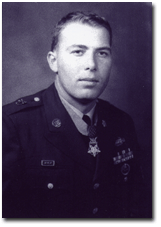 En route to his first tour in Vietnam, Staff Sergeant Drew Dix was pulled off his beloved special forces A-team and reassigned to the Central Intelligence Agency. As the lone American, Dix was assigned to lead the Provincial Reconnaissance Unit, an armed force of local mercenaries, to fight the communist aggression. The Dix story begins during the Tet Offensive of 1968. Although outnumbered at least thirty to one, Dix lead a small contingent of troops in a harrowing fifty-six hour battle against two Viet Cong battalions. The action earned Dix the Medal of Honor. Determined to rescue the civilians and restore Chau Doc, Dix took matters into his own hands.
En route to his first tour in Vietnam, Staff Sergeant Drew Dix was pulled off his beloved special forces A-team and reassigned to the Central Intelligence Agency. As the lone American, Dix was assigned to lead the Provincial Reconnaissance Unit, an armed force of local mercenaries, to fight the communist aggression. The Dix story begins during the Tet Offensive of 1968. Although outnumbered at least thirty to one, Dix lead a small contingent of troops in a harrowing fifty-six hour battle against two Viet Cong battalions. The action earned Dix the Medal of Honor. Determined to rescue the civilians and restore Chau Doc, Dix took matters into his own hands.
He saved a young US nurse, eight USAID volunteers, two Filipino workers, a young Vietnamese girl and the wife and children of the Province Chief. Acting alone, Dix assaulted 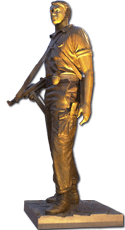 enemy strongholds, secured key buildings and captured over twenty prisoners including a General Officer who turned out to be one of the highest ranking officials ever seized during the Vietnam War. Drew Dix is the first enlisted Green Beret to have been awarded the Medal of Honor. He received a direct commission to first Lieutenant and retired as a major after twenty years in the Army. Today in the fight against terrorism, his years of experience in special operations and unconventional assignments are being utilized to serve our country in the area of Homeland Security.
enemy strongholds, secured key buildings and captured over twenty prisoners including a General Officer who turned out to be one of the highest ranking officials ever seized during the Vietnam War. Drew Dix is the first enlisted Green Beret to have been awarded the Medal of Honor. He received a direct commission to first Lieutenant and retired as a major after twenty years in the Army. Today in the fight against terrorism, his years of experience in special operations and unconventional assignments are being utilized to serve our country in the area of Homeland Security.
Facts about the sculpture:
You will note that Sqt. Dix is holding and wearing some unusual weapons. Because he was with Special Forces he was permitted to use weapons of his choice. The submachine gun is a Karl Gustav or Swedish K. The side arm is a Buntline Special with a 12 inch barrel. He acquired it when a friend asked if he could have the Barretta Dix had never used and insisted that Dix take the Buntline in trade. He first wore it as a lark to a day of target practice and was such a dead shot with it at 100 yards that his Vietnamese troops insisted that he carry it from then on.
Back to the top
“The Fighter”
William Crawford
WWII
1943
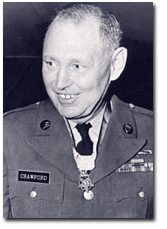 At a young age Bill Crawford learned to defend himself by boxing. As a soldier during World War II his fighting skills were put to the ultimate test. Crawford’s path to the Medal of Honor began in 1943 in Italy. As the company scout, Army Private Crawford discovered three hidden German machine gun nests. Alone and unable to alert his fellow soldiers of the awaiting ambush – Crawford took matters into his own hands. He single handedly engaged the enemy – with only his rifle and grenades he destroyed all three enemy emplacements. As his company advanced, he volunteered to stay behind to aid a wounded friend only to be captured by enemy troops.
At a young age Bill Crawford learned to defend himself by boxing. As a soldier during World War II his fighting skills were put to the ultimate test. Crawford’s path to the Medal of Honor began in 1943 in Italy. As the company scout, Army Private Crawford discovered three hidden German machine gun nests. Alone and unable to alert his fellow soldiers of the awaiting ambush – Crawford took matters into his own hands. He single handedly engaged the enemy – with only his rifle and grenades he destroyed all three enemy emplacements. As his company advanced, he volunteered to stay behind to aid a wounded friend only to be captured by enemy troops.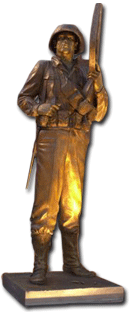
As a POW, Crawford endured nineteen months in a Nazi prison camp. His hometown golden gloves experience came to the surface when he was put to the test and knocked out a Nazi guard during a fight. Back home his family had presumed Crawford was killed in action and his Medal of Honor was presented to his father posthumously. In 1945 his family rejoiced in his liberation from Germany and he returned to Colorado living a very humble life. After his Army retirement Crawford took a job as a custodian at the Air Force Academy and took on a special role befriending and mentoring the young cadets. One former cadet, now an Air Force Colonel has written “The Janitor’s Ten Lessons In Leadership” now a mandatory reading for the entire Air Force. It wasn’t until over forty years after his heroic action that Crawford was presented the Medal of Honor in person. He was officially presented the medal by President Ronald Reagan at the 1985 Air Force Academy graduation ceremony.
Facts about the sculpture:
The uniform worn by Bill is typical GI issue used by troops in Africa and Italy. He was in the Texas 38th Infantry Division which landed at Salerno. The small shovel on his back was used to dig fox holes. In addition to the long bayonet on his M-1 rifle, he carried a number of hand grenades and an extra cartridge belt.
Back to the top
“The Captain”
Carl Sitter
Korea
1950
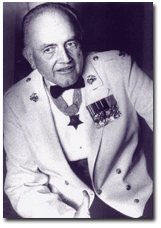 In the winter of 1950 General Douglas MacArthur declared “the troops will be home by Christmas, but unknown to the US Commander, the First Marine Division was being surrounded by over 120,000 Chinese troops. On November 29th at the Chosin Reservoir in North Korea Captain Carl Sitter received his fateful orders to take East Hill. In unbearably frigid sixty below zero conditions Sitter and his men of George Company headed up East Hill. Out numbered at least twenty to one they were engaged by the ferocious Chinese troops
In the winter of 1950 General Douglas MacArthur declared “the troops will be home by Christmas, but unknown to the US Commander, the First Marine Division was being surrounded by over 120,000 Chinese troops. On November 29th at the Chosin Reservoir in North Korea Captain Carl Sitter received his fateful orders to take East Hill. In unbearably frigid sixty below zero conditions Sitter and his men of George Company headed up East Hill. Out numbered at least twenty to one they were engaged by the ferocious Chinese troops 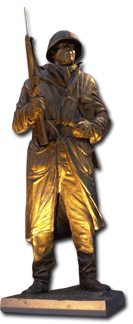 for three nights – many times in hand to hand combat. During the brutal battle Sitter remembers feeling as though he was protected by an invisible shield. He gallantly executed his orders and today his heroic leadership is legendary in the annals of Marine Corps history.
for three nights – many times in hand to hand combat. During the brutal battle Sitter remembers feeling as though he was protected by an invisible shield. He gallantly executed his orders and today his heroic leadership is legendary in the annals of Marine Corps history.
He strategically maneuvered his men to successfully take and hold East Hill. A leader by example Sitter yelled words of inspiration and encouragement for his “boys” to perform. Wounded several times Sitter refused evacuation and determinedly led his men out of the Chosin Reservoir trap leaving no one behind. One of “Carl’s Boys”, now a retired Marine General dubbed his association with Captain Sitter as the “highlight of my life”. Sitter retired as a highly respected Marine Colonel. Just one month prior to his death at the age of seventy-seven, Sitter was to graduate from a seminary University with a four year degree
Facts about the sculpture:
The navy parka, scarf and mittens worn by Captain Sitter were typical attire for soldiers trying to keep warm in the Northern part of Korea at Chosin Reservoir, the site of his Medal action. He wore a Colt .45 in a shoulder holster because he had done so during WWII and it had deflected a bullet and most likely saved his life.
Back to the top
“The Lieutenant”
Raymond G. (Jerry) Murphy
Korea
1953
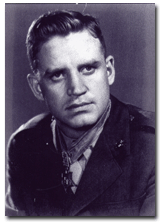 Operation Clambake was a detailed, well-planned raid for the Ungok hill mass in Korea. However, the cold February day of 1953 turned grim very quickly as the 1st and 2nd Marine platoons of Able Company began their assault. 2nd Lieutenant Raymond “Jerry” Murphy was the 3rd platoon leader with the assignment of evacuation. As the raid progressed, Lieutenant Murphy became uneasy and felt his fellow Marines might be in trouble. Defying direct orders, Murphy led a small group of men up the hill to assess the situation. It was as he suspected. The assault had stalled and most of the senior officers and NCOs had been killed.
Operation Clambake was a detailed, well-planned raid for the Ungok hill mass in Korea. However, the cold February day of 1953 turned grim very quickly as the 1st and 2nd Marine platoons of Able Company began their assault. 2nd Lieutenant Raymond “Jerry” Murphy was the 3rd platoon leader with the assignment of evacuation. As the raid progressed, Lieutenant Murphy became uneasy and felt his fellow Marines might be in trouble. Defying direct orders, Murphy led a small group of men up the hill to assess the situation. It was as he suspected. The assault had stalled and most of the senior officers and NCOs had been killed.
Knowing the raid had failed, Murphy organized and led a heroic rescue effort. Under intense enemy fire Murphy made countless runs up the hill on a mission to save lives. As the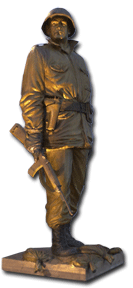 other men pulled back Murphy provided cover and while maneuvering across the hillside stalking the enemy to protect further casualties. Only after he was sure all the Marines were accounted for – would he leave the battlefield. Murphy sustained numerous wounds but refused treatment until everyone else had been treated. Upon presenting Murphy the Medal of Honor President Eisenhower was quoted as saying “What is it in the water out there in Pueblo, all you guys turn out to be heroes.” In his final years this hero was still protecting his fellow Veterans by volunteering at the VA hospital in Albuquerque. His heart was devoted to protecting others and aiding those in need.
other men pulled back Murphy provided cover and while maneuvering across the hillside stalking the enemy to protect further casualties. Only after he was sure all the Marines were accounted for – would he leave the battlefield. Murphy sustained numerous wounds but refused treatment until everyone else had been treated. Upon presenting Murphy the Medal of Honor President Eisenhower was quoted as saying “What is it in the water out there in Pueblo, all you guys turn out to be heroes.” In his final years this hero was still protecting his fellow Veterans by volunteering at the VA hospital in Albuquerque. His heart was devoted to protecting others and aiding those in need.
Facts about the sculpture:
Lt. Murphy is standing partially on sandbags, one of which is leaking sand from a bullet hole. The area where his MOH action took place was the side of a hill where there were a number of dug-out emplacements that were fortified with sandbags. The heavy parka and gloves were necessary due to the extreme cold of the Korean winters, some were the coldest on record during the years of 1950 to 1953.
Where are they now?
Bill Crawford and Carl Sitter died in 2000, shortly before the unveiling of their statues. Mr. Crawford is buried at the Air Force Academy and Mr. Sitter at Arlington National Cemetery. Jerry Murphy passed away in 2007 and is buried at the Santa Fe, NM National Veteran’s Cemetery. Drew Dix is retired and living on a ranch in New Mexico.
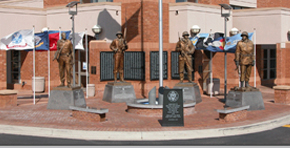
This memorial was made possible by the generous donations of:
- Robert Rawlings
- Bill Coors
- Rita Bass
- The Coors Foundation
- El Pomar Foundation
- Boettcher Foundation
- Kenneth Kendall King Foundation
- Gates Foundation
With special thanks to…….
- David Dirrim
- William Yates
- Rick Solony
- T&T Electric
- Aaron Ghini Masonry
- The City of Pueblo
- K.R. Swerdferger Cons.
- Pueblo Water Board
- H.W. Houston Cons.
- Pride City Awning
- Mac Indoe Plumbing
- Pueblo Urban Renewal




